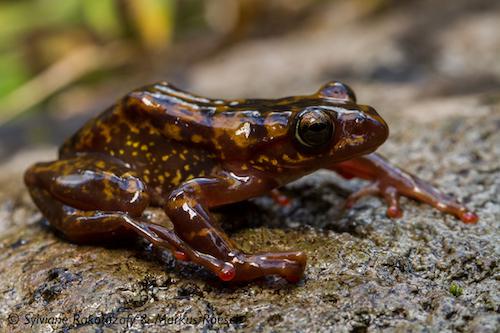Lovasoa Manuelle Sylviane Rakotozafy
This project aims to:
(i) Provide information on current distribution and population size of Boophis williamsi. Apart from its known distribution, new areas in Ankaratra will be extensively survey to search for new populations.
(ii) Determine the extent of gene flow among remnant populations of Boophis williamsi to provide a robust assessment on its risk of extinction, and hopefully identifying the influence of habitat fragmentation on migration and genetic diversity.
(iii) Improve knowledge and influence attitude and perception of local communities to get them motivated to assist in conservation of Ankaratra.
This will serve as a baseline for establishing a long term monitoring in the area that will enable to detect population trend and change, which might result from the continued deforestation and habitat alteration pressures in this area. All of this information is extremely useful to develop appropriate management plans for Boophis williamsi and to save it from extinction.

Boophis williamsi. ©Sylviane Rakotozafy and Markus Roesch.
Boophis williamsi is classified as Critically Endangered under Red listing criteria and is amongst the most threatened amphibians of Madagascar. It can only be found in high altitude streams in the Ankaratra Massif (where the amphibian chytrid fungus has been reported recently) and is highly threatened by habitat loss due to fire, illegal logging, cattle grazing, expansion of agriculture and charcoal production. All these activities have determined heavy soil erosion and sedimentation, which have been responsible for the pollution of the frog’s breeding sites. Furthermore, the population size of this species seems very small.

Despite all these threats, much remains unknown about this CR species. Establishing baseline monitoring of Boophis williamsi populations, infer its distribution, abundance and the extent of gene flow of all known populations is now of paramount importance to prevent its extinction.
This project has been listed among the high research priority of the second Amphibian Conservation Action Plans for Madagascar (2016-2020) which was launched after the organization of the ACSAM2 (A Conservation Strategy for the Amphibians in Madagascar, II meeting. Ranomafana 2014).
In Ankaratra, forest patrols by the local associations with the support of the Ministry of Environment and Forest in Ambatolampy is one of the major conservation management actions that aims to monitor forest loss and illegal activities. Conducting social science, to improve knowledge of local people and to influence their perception and behaviour is vital to motivate them to better protect the Ankaratra Massif, which will contribute to the conservation effort of the local communities in Ankaratra.